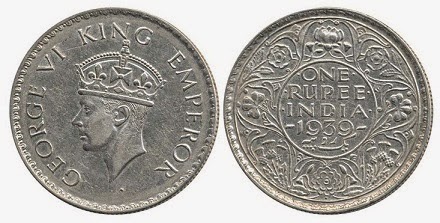Tiberius Denarius and Tribute Penny
This work contains in-text citations.
By Dr. Nilaish (Sometime Fellow of Royal Numismatic Society, London)
There are two citations from the Bible written in 1611 which loosely translated the word ''denarius'' to "Penny" as English Penny of King James was a small silver coin.
Mark 12:14: Should we pay them, or should we not?” And they came and said to him, “Teacher, we know that you are sincere, and show deference to no one; for you do not regard people with partiality, but teach the way of God in accordance with truth. Is it lawful to pay taxes to the emperor, or not?
Mark 12:15: ..But knowing their hypocrisy, he said to them, “Why are you putting me to the test? Bring me a denarius and let me see it.”
The Greek text uses the word dēnarion [1] and was misinterpreted in the Bible. However, reigning monarch during Jesus' life was Tiberius [16 Nov. 42 BCE - 16 March 37 AD] who may have issued orders to crucify him. The concerned act in the Bible refers to use of denarius of Tiberius. However, there is no evidence which suggests that Tiberius denarius was in circulation in Judaea (Jerusalem) during Jesus' life time. Some other suggestions are given by experts [2]: Tetradrachm of Tiberius with Augustus on the reverse. Another suggestion [3]: Denarius of Augustus with Gaius and Lucius on the reverse or coins of Julius Caesar or Mark Antony and Germanicus are considered possibilities. Regardless of these possibilities still this coin existed in the time of Jesus and thus adds to its desirability among collectors [4]. The Italian Painter Titian painted in 1516 showing this act mentioned in the Bible [Fig. 1]. The painting is titled ''Tribute Money" [in Italian: Cristo della moneta – literally Christ of the coin].
Notes & References:
1. Thayer's Lexicon: δηνάριον .
2. Lewis, Peter E.; Bolden, Ron (2002). The Pocket Guide to Saint Paul: Coins Encountered by the Apostle on his Travels. Wakefield Press. p. 19.
3. Michael E. Marotta (2001). Six Caesars Of The Tribute Penny. Archived from the original on 12 October 2011[ online version is not available anymore].
4. Akerman, John Y. (1855). On the Causes which influence the value of the Coins: IX. (Letter to the Editor). The Numismatic Chronicle, Volume 17. Royal Numismatic Society. p. 52.
5. Akerman, John Y. (1855). ibid.
By Dr. Nilaish (Sometime Fellow of Royal Numismatic Society, London)
There are two citations from the Bible written in 1611 which loosely translated the word ''denarius'' to "Penny" as English Penny of King James was a small silver coin.
Mark 12:14: Should we pay them, or should we not?” And they came and said to him, “Teacher, we know that you are sincere, and show deference to no one; for you do not regard people with partiality, but teach the way of God in accordance with truth. Is it lawful to pay taxes to the emperor, or not?
Mark 12:15: ..But knowing their hypocrisy, he said to them, “Why are you putting me to the test? Bring me a denarius and let me see it.”
The Greek text uses the word dēnarion [1] and was misinterpreted in the Bible. However, reigning monarch during Jesus' life was Tiberius [16 Nov. 42 BCE - 16 March 37 AD] who may have issued orders to crucify him. The concerned act in the Bible refers to use of denarius of Tiberius. However, there is no evidence which suggests that Tiberius denarius was in circulation in Judaea (Jerusalem) during Jesus' life time. Some other suggestions are given by experts [2]: Tetradrachm of Tiberius with Augustus on the reverse. Another suggestion [3]: Denarius of Augustus with Gaius and Lucius on the reverse or coins of Julius Caesar or Mark Antony and Germanicus are considered possibilities. Regardless of these possibilities still this coin existed in the time of Jesus and thus adds to its desirability among collectors [4]. The Italian Painter Titian painted in 1516 showing this act mentioned in the Bible [Fig. 1]. The painting is titled ''Tribute Money" [in Italian: Cristo della moneta – literally Christ of the coin].
Fig. 1: Cristo della Moneta by Titian in 1516 - Illustration of Tribute Penny before 1611.
Image Courtesy: Wikipedia [Erwin Jurschitza 2005].
There is a fine line between a myth and a religious belief and this Tiberius denarius is a good example to explore. However, there is no evidence which suggests that these coins were in circulation in Judaea where Jesus lived before being crucified. The widely attributed 'Tribute Penny' is shown in Fig. 2.
Fig. 2: Tiberius Denarius, Circa 14-37 A.D.
Obverse: Portrait of Tiberius with legend, Reverse: Mother Livia Sitting with title Pontus Maxim.
Obverse with inscription: Ti[berivs] Caesar Divi Avg[vsti] F[ilivs] Avgvstvs” (“Caesar Augustus Tiberius, son of the Divine Augustus”), claiming that Augustus was a god. The reverse shows a seated female, usually identified as Livia depicted as Pax [5]. Jesus was crucified in April 30 AD. This coin was circulated in Rome during his lifetime.
Notes & References:
1. Thayer's Lexicon: δηνάριον .
2. Lewis, Peter E.; Bolden, Ron (2002). The Pocket Guide to Saint Paul: Coins Encountered by the Apostle on his Travels. Wakefield Press. p. 19.
3. Michael E. Marotta (2001). Six Caesars Of The Tribute Penny. Archived from the original on 12 October 2011[ online version is not available anymore].
4. Akerman, John Y. (1855). On the Causes which influence the value of the Coins: IX. (Letter to the Editor). The Numismatic Chronicle, Volume 17. Royal Numismatic Society. p. 52.
5. Akerman, John Y. (1855). ibid.



